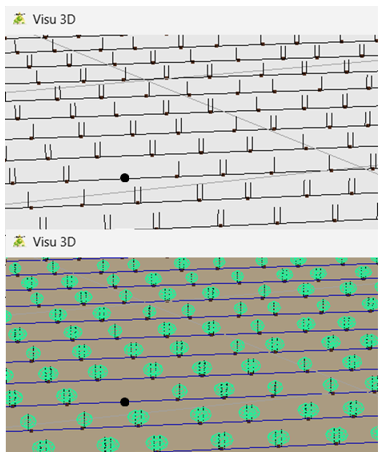Growth models
Trunk growth model
In agroforestry, trees grow freely. After an installation phase in which growth may be reduced, growth is roughly linear.
A maximum plateau has been defined, but the trees will be cut at full growth before reaching this plateau: loggingDiameter parameter in the treeSpecies input file. It was calculated using data from 6 French cities, if not from the floriscope.io website.

Diameter growth for fitters Addition (double) - Plants
The diameter of the trunk at 1.30 cm at age 0 (planting) is 0.
For each forest species available in the National Forest Inventory from 2009 to 2022, the average annual increment is calculated for non-dominated and non-injured trees with a diameter of at least 7.5 cm, aged less than 15 years. The standard deviation calculated around this average reflects the diversity of situations throughout France, and is therefore unsuitable for a given plot: the standard deviation is estimated at 1/5 of the average.
For species not available in the NFI, the average of available species is used as an estimator, for each height category (modulator column from 1 to 5 in treeSpecies).
For each tree with a diameter of 8 cm or more, the annual increase in diameter is derived from a normal distribution based on the mean and standard deviation. Before 8 cm diameter, to take account of a possible transplant crisis, a reduction factor randomly selected between 1 and 0.75 is applied.
When a plot is arranged, the default fertility index is 2 - average. Choosing 1 or 3 implies an average annual growth multiplier of 0.8 or 1.2.
With a diameter growth reference
When diameter measurements are available at age1 from a site that is relevant to the soil and climate conditions and the monitoring expected at the target site, EcoAF suggests that you enter Age of measurement, Mean diameter (mm) and Sigma diameter (mm) for this sample in the Add - Plants or trees (one measurement) layout.
Age is the age (approximate if necessary) of the trees or plants at the simulation start date. This allows pre-existing trees to be declared.
For each tree simulated, the diameter value at age1 will be drawn according to a normal distribution, and all the other values will be deduced from the straight line also passing through the diameter at planting (0). The values after the transplant crisis are therefore underestimated, while those after the crisis are overestimated.
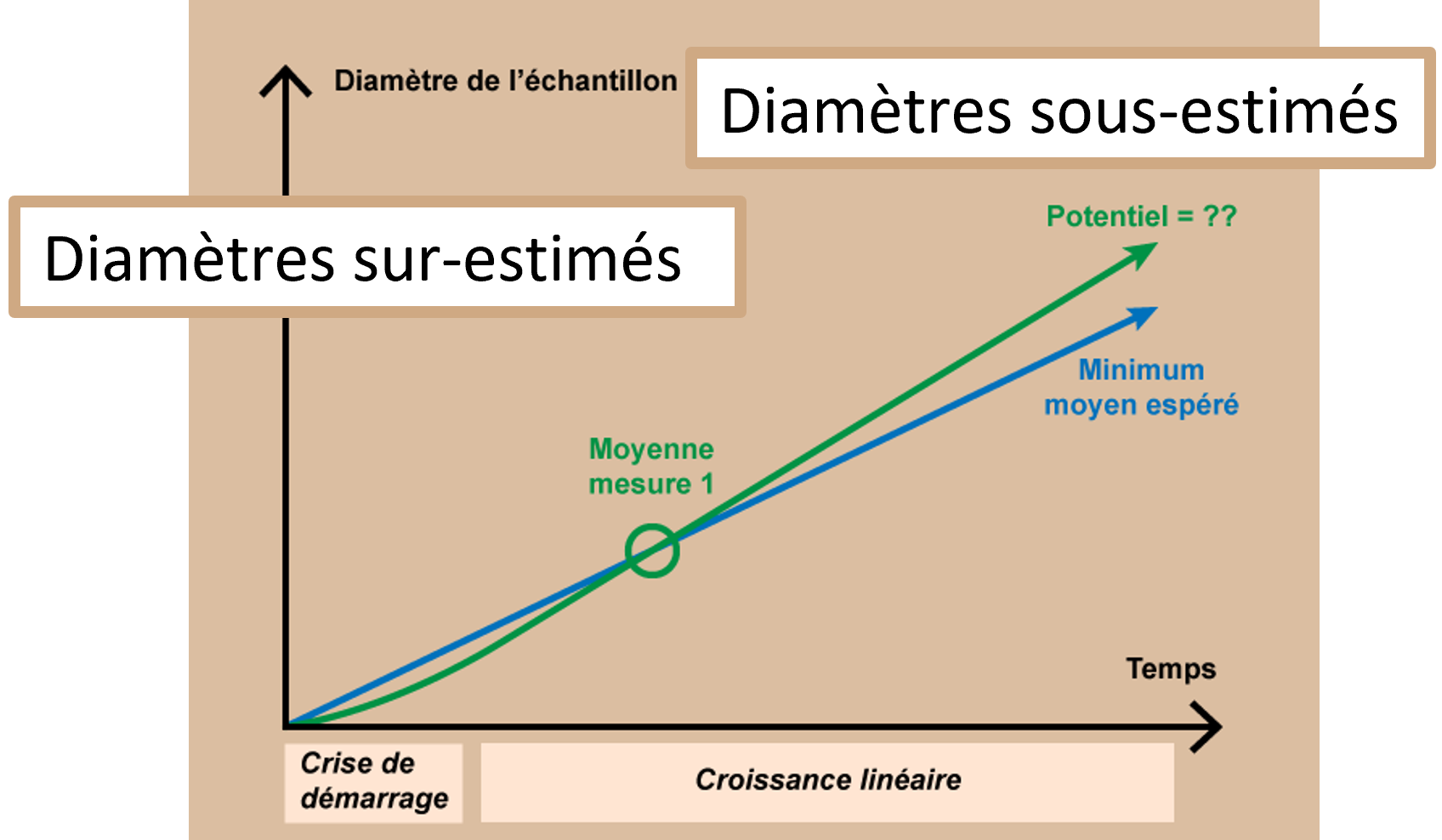
With two growth references in diameter
When diameter measurements are also available at age2, and age1 is after the transplanting crisis, EcoAF suggests entering Measurement Age 1, Measurement Age 2, Mean Diameter 1, Sigma Diameter 1, Mean Diameter 2 (in mm) for this sample in the Add - Plants or trees (two measurements) layout. These values are provided by the DIAFNOSTIC application currently being developed by INRAE and Agroof.
For each tree simulated, the diameter value at age1 will be drawn according to a normal distribution. The values will be deduced from the straight line also passing through the diameter at plantation = 0. Subsequent values will be deduced from the annual increment between Mean Diameter 1 and Mean Diameter 2.

Production and growth of fruit trees
The Adding fruit trees arrangement only concerns the 6 main fruit species in arboriculture associated with market gardening (most often), or other forms of agroforestry. They are pruned to encourage fruit production, watered and fertilised. The life span of these trees is short, and they are replaced after 20 years by new trees to maintain productivity.
Growth in diameter at 0.20 cm is linear between planting (1 cm) and uprooting (or topping) at 20 years (20 cm).
These same species are given in the other tree arrangements, because fruit species are also mixed with other species in the agroforestry lines, for other uses. Their fruit production is therefore not recorded!
Height growth
Height at planting
-
Fitters Adders (in duplicate) - Plants: this is drawn linearly between the declared min(m) and max(m) heights.
-
Fitters Addition - Plants or trees (one/two measurements): this is set at 0.5 m.
-
Fitters Add fruit trees: this is declared for all plants of the species by Height(m).
The height of a tree is then deduced each year from its circumference in mm and the parameters in the treeSpecies file.
For the Add fruit trees layout, height growth is linear between the initial Height(m) declared and the maximum height of treeSpecies heightMax(m), reached at 7 years, then remains at this value.
For all other cases, we use the treeSpecies parameter dbhMiddle_Girth, which is the diameter limit between two formulas to calculate the corresponding height via two other parameters (the 3 parameters are deduced from calculations on urban trees):
Height_limit_m = HG_interceptMiddle + HG_slopeMiddle * HG_dbhMiddle_Girth
Before this height limit, linear growth from the height at planting, then when it is exceeded :
Height_m = HG_interceptMiddle + circonférence_cm * HG_slopeMiddle
Finally, the height stagnates when the maximum height is reached heightMax(m).
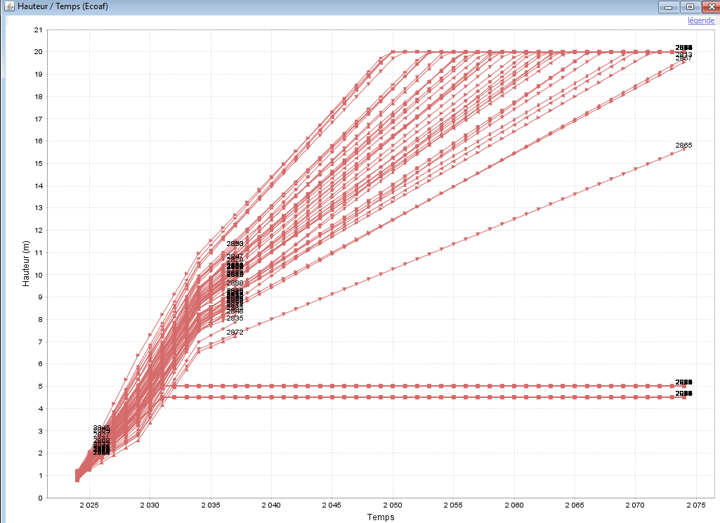
Shape of crown
-
Proportion of free trunk under the crown: 10% of the height for bushy species and pollarded trees, 40% otherwise (crownBaseHeightOverHeight parameter in the treeSpecies input file), and a maximum trunk height free of branches set at 6m.
-
The maximum radius of the crown of forest trees is at least 0.1 m, and is then deduced from the height, using 3 parameters (deduced from calculations on trees in town, or from floriscope.io data otherwise) from the treeSpecies input file: Maximum_radius_m = crownIntercept + crownSlope * (1- crownBaseHeightOverHeight ) * height_m
-
Diamond aspect of the crown, for all species: crownProfile parameter in the treeSpecies input file: { 0; 0; 25; 80; 50; 100; 75; 80; 100; 0 } means that at 0% of the crown, its diameter is 0% of the maximum diameter, at 25% of the crown, its diameter is 80% of the maximum diameter, etc...
-
Tree crown colour: defined by colorRGB (r,g,b).
-
An individual 1m high protection is drawn for each tree.Nuance for fruit trees: at Age=0, Radius_maximal_m = ¼ Length_houppier_m, linear up to 7 years and crownMaxDiameter(m), then stable.
Productions
For the moment, only fruit production is integrated, for 6 common species.
There are plans to add other productions, for other species.
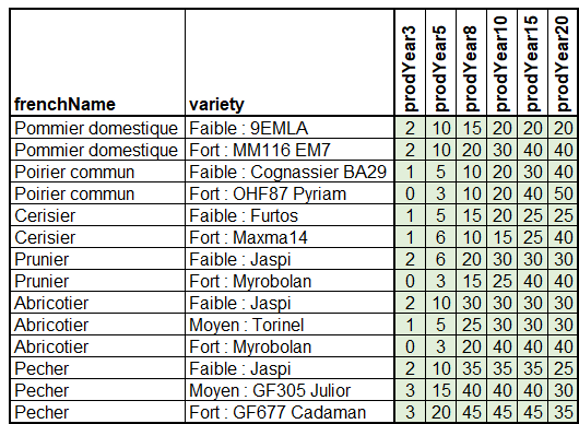
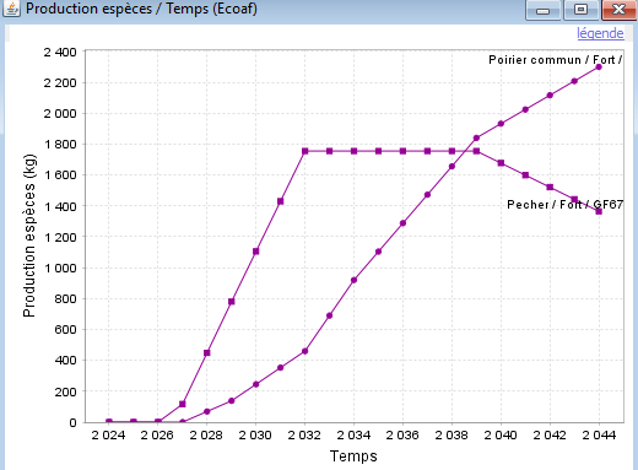
Hazards
The only mortality risk is 10% for each tree at 2 years.
Planting more densely using the Double Add - Plants layout not only produces more wood, but also avoids overgrowth: the best tree is thinned out after the 10th year.


